Score: 8/10 (Great)
Pros:Fast processing speeds, Live Tiles are fantastic, WP8 is smooth as silk, design isn't anything new but it works really good, rear-facing camera took really good photos. | Cons:Microsoft Store has a noticeable lack of apps, screen resolution won't impress anyone, material used on the back of the phone is too slippery, front-facing camera is extremely grainy. |
Windows Phone 8 is finally here and it one word, it is truly awesome. One of the largest manufacturers of Windows Phone 8 devices is Nokia. Their latest flagship device is the Nokia Lumia 920 which is only available on AT&T. They did however release another Windows Phone 8 device on AT&T which is called the Nokia Lumia 820. The Lumia 820 is considered to be a mid-range device by both Nokia and AT&T. While it certainly doesn't pack in all the features of the Nokia Lumia 920, it really does feel like a very high quality phone. The Nokia Lumia 820 is currently selling at AT&T for only $50 with a 2-year contract. At that price, is the Nokia Lumia 820 a good deal? Or should you pay an extra $50 and go all the way with the 920? Let's find out.
Design/Build Quality
Personally, I really liked the design of the Nokia Lumia 820. Sure, it looks like your standard black smartphone design but, it feels like a really great, high quality handset. With a thickness of 9.9 mm and weighing in at 160 g, the Lumia 820 is on the chunky side when it comes to smartphones. Although the Lumia 820 is heavier and thicker than most current handsets, it actually felt really great to hold and I didn't mind the extra weight at all. On the front of the device, you will find your 4.3-inch screen with a resolution of 800 x 480. Above that is the Lumia 820's VGA front-facing camera. Below the screen is the standard Windows Phone back, home, and search capacitive touch buttons. On the back of the phone is the 8MP camera with LED flash and Carl Zeiss lens. On the right, is the volume rocker, power/lock button, and dedicated camera launcher. On the top you have a 3.5 mm headphone jack and on the bottom you will find your standard micro-USB syncing/charging port.
The design for the Lumia 820 is nothing we haven't seen before but, it works great. While the weight and thickness of the phone may scare off a few people, it did not bother me one bit. One design aspect that I didn't like at all of the phone was the texture on the back of the device. It is a plastic material but, it is extremely slippery and will cause you to drop the 820 a few times like I did. Also, after about 5 days of use with the 820, I found a small scratch on the right-hand side of the screen. I had not exposed the phone to anything that could cause a scratch to the screen and I am still trying to figure out how it got there. The Lumia 820's design does not bring anything new to the table but, it works pretty good. Although it has a couple build quality issues, overall, the design works out just fine.
Design/Build Quality
Personally, I really liked the design of the Nokia Lumia 820. Sure, it looks like your standard black smartphone design but, it feels like a really great, high quality handset. With a thickness of 9.9 mm and weighing in at 160 g, the Lumia 820 is on the chunky side when it comes to smartphones. Although the Lumia 820 is heavier and thicker than most current handsets, it actually felt really great to hold and I didn't mind the extra weight at all. On the front of the device, you will find your 4.3-inch screen with a resolution of 800 x 480. Above that is the Lumia 820's VGA front-facing camera. Below the screen is the standard Windows Phone back, home, and search capacitive touch buttons. On the back of the phone is the 8MP camera with LED flash and Carl Zeiss lens. On the right, is the volume rocker, power/lock button, and dedicated camera launcher. On the top you have a 3.5 mm headphone jack and on the bottom you will find your standard micro-USB syncing/charging port.
The design for the Lumia 820 is nothing we haven't seen before but, it works great. While the weight and thickness of the phone may scare off a few people, it did not bother me one bit. One design aspect that I didn't like at all of the phone was the texture on the back of the device. It is a plastic material but, it is extremely slippery and will cause you to drop the 820 a few times like I did. Also, after about 5 days of use with the 820, I found a small scratch on the right-hand side of the screen. I had not exposed the phone to anything that could cause a scratch to the screen and I am still trying to figure out how it got there. The Lumia 820's design does not bring anything new to the table but, it works pretty good. Although it has a couple build quality issues, overall, the design works out just fine.
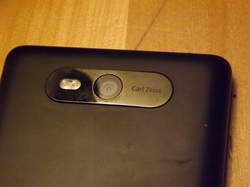
Hardware
For a mid-range phone, the Nokia Lumia 820 actually packs some pretty impressive specs. Under the hood, you will find a Qualcomm Snapdragon S4 1.5GHz dual-core processor, 1GB of RAM, and 8GB of internal storage. Overall, the Nokia Lumia 820 is a pretty snappy device.
Swiping your homescreen, web pages, and apps is extremely smooth and fluid. All of the games that I tested also ran great with no lag whatsoever.
The 4.3-inch screen has a resolution of 800 x 480 which looks alright. Live Tiles are vibrant and colorful but, zooming in on text will reveal the screen resolutions weakness.
The Nokia Lumia 820 also features 2 cameras. The rear-facing one captures images up to 8MP and records videos up to 1080p HD. The front-facing one captures pictures and videos in a VGA resolution. The rear-facing camera took really good pictures, especially when you consider the price. The front-facing one however, was quite grainy and failed to
impress.
For a mid-range phone, the Nokia Lumia 820 actually packs some pretty impressive specs. Under the hood, you will find a Qualcomm Snapdragon S4 1.5GHz dual-core processor, 1GB of RAM, and 8GB of internal storage. Overall, the Nokia Lumia 820 is a pretty snappy device.
Swiping your homescreen, web pages, and apps is extremely smooth and fluid. All of the games that I tested also ran great with no lag whatsoever.
The 4.3-inch screen has a resolution of 800 x 480 which looks alright. Live Tiles are vibrant and colorful but, zooming in on text will reveal the screen resolutions weakness.
The Nokia Lumia 820 also features 2 cameras. The rear-facing one captures images up to 8MP and records videos up to 1080p HD. The front-facing one captures pictures and videos in a VGA resolution. The rear-facing camera took really good pictures, especially when you consider the price. The front-facing one however, was quite grainy and failed to
impress.
The call quality of the Nokia Lumia 820 was great. Everyone I talked to with the phone said that I sounded like I was standing right next to them. The voices of people I talked to also sounded great on my end as well.
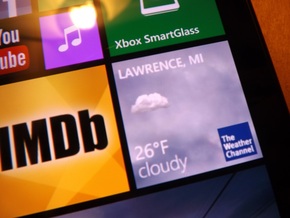
Live Tiles bring you live, relevant information
Software
The Nokia Lumia 820 runs Windows Phone 8. Windows Phone 8 just came out this past October and it is a really beautiful operating system. The biggest feature of Windows Phone
8 is Live Tiles. This was first introduced in Windows Phone 7 and since then, it has been one of the main selling points of Windows Phone devices. Live Tiles are constantly updating with live information that is relevant to your interests (For example, The Weather Channel Live Tile will show the temperature in your area and your location on a mini radar). It is an ingenious idea and it works beautifully. A new addition to Live Tiles in Windows Phone 8 is the ability to resize the Tiles. This feature has been asked for ever since Windows Phone 7 and we finally have it with Windows Phone 8. You can resize all Tiles to a small and medium size with certain Tiles supporting a wide option.
Customization is always a huge thing that I look for in my tech. Thankfully, WP8 offers a very broad level of
customization. While Android may technically be the most customizable mobile OS out there, I found that WP8 offered a more personal level of customization. Because of the ability to resize Live Tiles, the fact that Live Tiles are always showing relevant information for you, and that you can change the theme of the phone, I really felt like I could make the Nokia Lumia 820 my own device. After you fully setup your WP8 device to your likings, you really feel like it is a little window into your life.
Another huge plus on Windows Phone 8 is how smooth it is. Sliding through your homescreen, apps, and web browser are all buttery smooth operations and feel absolutely wonderful. While it is true that part of this fluidness is due to the dual-core processors, a larger part of it is thanks to the way WP8 operates.
The Nokia Lumia 820 runs Windows Phone 8. Windows Phone 8 just came out this past October and it is a really beautiful operating system. The biggest feature of Windows Phone
8 is Live Tiles. This was first introduced in Windows Phone 7 and since then, it has been one of the main selling points of Windows Phone devices. Live Tiles are constantly updating with live information that is relevant to your interests (For example, The Weather Channel Live Tile will show the temperature in your area and your location on a mini radar). It is an ingenious idea and it works beautifully. A new addition to Live Tiles in Windows Phone 8 is the ability to resize the Tiles. This feature has been asked for ever since Windows Phone 7 and we finally have it with Windows Phone 8. You can resize all Tiles to a small and medium size with certain Tiles supporting a wide option.
Customization is always a huge thing that I look for in my tech. Thankfully, WP8 offers a very broad level of
customization. While Android may technically be the most customizable mobile OS out there, I found that WP8 offered a more personal level of customization. Because of the ability to resize Live Tiles, the fact that Live Tiles are always showing relevant information for you, and that you can change the theme of the phone, I really felt like I could make the Nokia Lumia 820 my own device. After you fully setup your WP8 device to your likings, you really feel like it is a little window into your life.
Another huge plus on Windows Phone 8 is how smooth it is. Sliding through your homescreen, apps, and web browser are all buttery smooth operations and feel absolutely wonderful. While it is true that part of this fluidness is due to the dual-core processors, a larger part of it is thanks to the way WP8 operates.
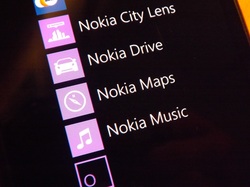
The Nokia Lumia 820, as well as all of Nokia's WP8 products, comes loaded with value added applications that Nokia has added onto their phones. These include Nokia City Lens, Nokia Drive, Nokia Maps, and Nokia Music. City Lens is this awesome augmented reality app that displays businesses and places of interest in your area through your camera lens. Drive is Nokia's own turn by turn navigational app and Maps is Nokia's own mapping service. Both of these work great together and it is some of the best mapping software you can get for a Windows Phone device. Music is basically Nokia's answer to Pandora and iHearRadio. I am a huge Pandora fan but, since there is no Pandora app available on the Microsoft Store, I resorted to using Nokia Music for my music streaming needs. Surprisingly enough, I found myself really enjoying my time with the app. Nokia crafted a really great music streaming service and is the best you will find on the Microsoft Store. All of these value added apps that Nokia adds to their WP8 phones is a huge selling point. Nokia is putting it all of the line with Windows Phone and they want you to purchase one of their phones if you are getting a WP8 device. Because of these apps that Nokia includes with their phones, it really helps narrow down the completion and makes you feel silly to purchase a WP8 device that isn't manufactured by Nokia.
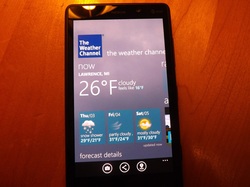
Apps on WP8 have a clean, modern feel
The way that applications are presented to you in WP8 is one of the things that I found I loved most. All applications have a WP look and feel to them (similar to how many iOS apps have an iOS look and feel to them). I found that many apps such as iMDB, The Weather Channel, Evernote, etc., were presented much more organized in WP8 than they were in Android. Everything in WP8 feels very clean and modern and it really gives the phone a great identity.
One of the biggest issues I had with WP8 though, was the lack of developer support in
the Windows Store (Microsoft's app store). There are only 150,000 apps available to download in the Windows Store and that is a significantly smaller selection than the app stores offered by both Apple and Google. Even though Windows Phone is younger than iOS and Android, it needs to get a larger selection of applications if it wants to have a chance of getting to where Android or iOS is right now. Many consumers purchase a phone based on the app selection available. As Android gathered more developers to develop apps for them, more people bought Android devices. At the current state Windows Store is in, it feels a lot like how the Android Market was before it became Google Play. While the apps are categorized into different sections, it feels like you are digging through a pile of garbage in hopes of finding a high quality app. One of my biggest complaints for Windows Phone though, is the fact that there are no apps for Google services. This means no apps for Google Search, YouTube, Maps, Blogger, Translate, etc. I understand that Microsoft wants people to use Bing as their search engine but, offer your users some choice. Until you can fix Bing and make it not so terrible, give me the choice to use Google Search. While mobile versions of YouTube and Blogger are functional, a dedicated app for these services would be much more fluid and easy to use.
One of the biggest issues I had with WP8 though, was the lack of developer support in
the Windows Store (Microsoft's app store). There are only 150,000 apps available to download in the Windows Store and that is a significantly smaller selection than the app stores offered by both Apple and Google. Even though Windows Phone is younger than iOS and Android, it needs to get a larger selection of applications if it wants to have a chance of getting to where Android or iOS is right now. Many consumers purchase a phone based on the app selection available. As Android gathered more developers to develop apps for them, more people bought Android devices. At the current state Windows Store is in, it feels a lot like how the Android Market was before it became Google Play. While the apps are categorized into different sections, it feels like you are digging through a pile of garbage in hopes of finding a high quality app. One of my biggest complaints for Windows Phone though, is the fact that there are no apps for Google services. This means no apps for Google Search, YouTube, Maps, Blogger, Translate, etc. I understand that Microsoft wants people to use Bing as their search engine but, offer your users some choice. Until you can fix Bing and make it not so terrible, give me the choice to use Google Search. While mobile versions of YouTube and Blogger are functional, a dedicated app for these services would be much more fluid and easy to use.
Final Verdict
For $50, the Nokia Lumia is a great deal. However,if you don't mind spending an extra $50, the Nokia Lumia 920 offers a better design, a larger screen with an HD display, and longer battery life. Both the 820 and 920 are great choices if you are looking to get a WP8 device with AT&T's service. If you want to get into the WP8 market but want to spend as little cash as possible, go with the 820. It offers many of the great features found in the 920 and feels like a well crafted piece of tech. If you want to get your hands on a WP8 device but don't mind spending a little more cash, go for the 920. It offers all of the features found on the 820 but, improves on many of them and even has some ones you won't find on it's younger brother. In the end, it is going to come down to a matter of price. Both of these phones are great choices but, as I said, the final decision of what Lumia to get will come down to the matter of how much you are willing to spend.
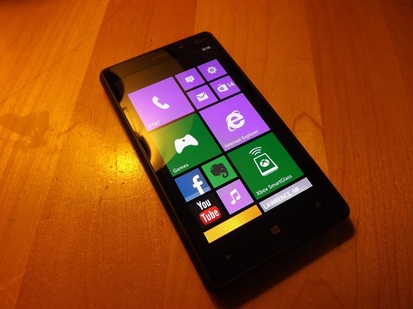


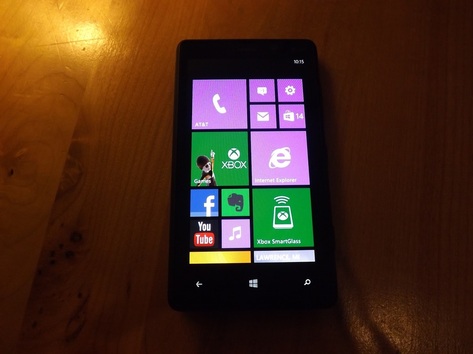
 RSS Feed
RSS Feed